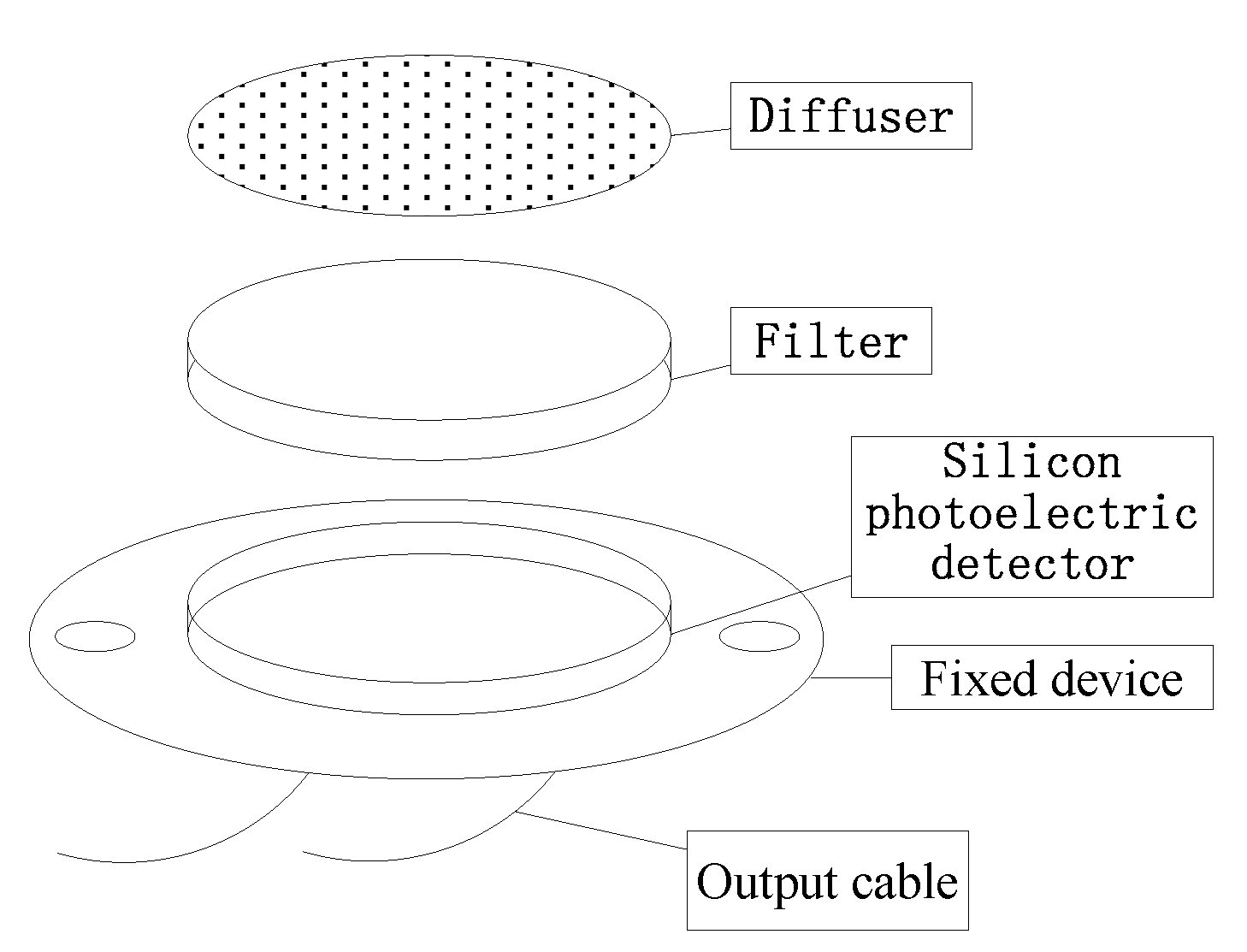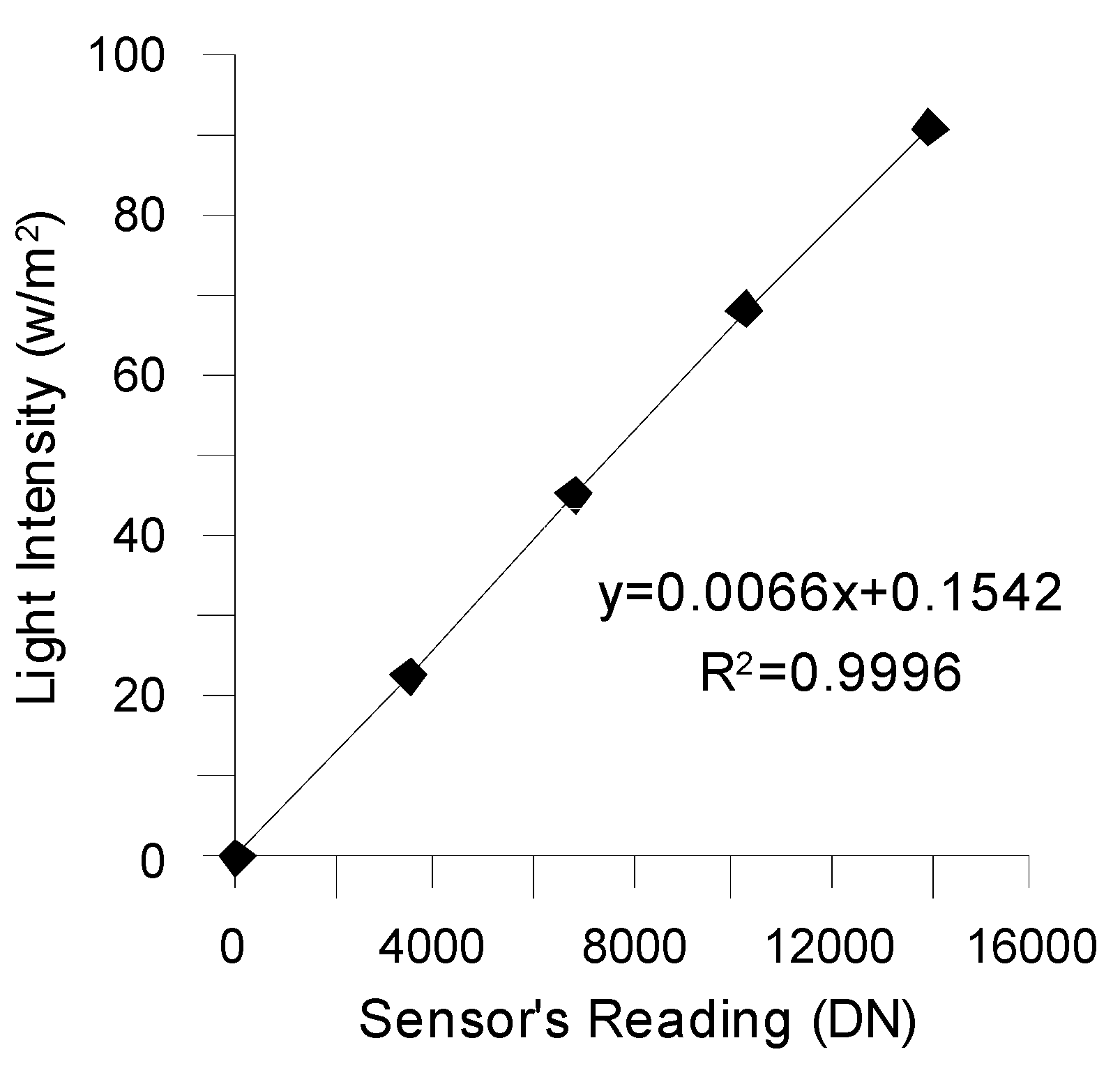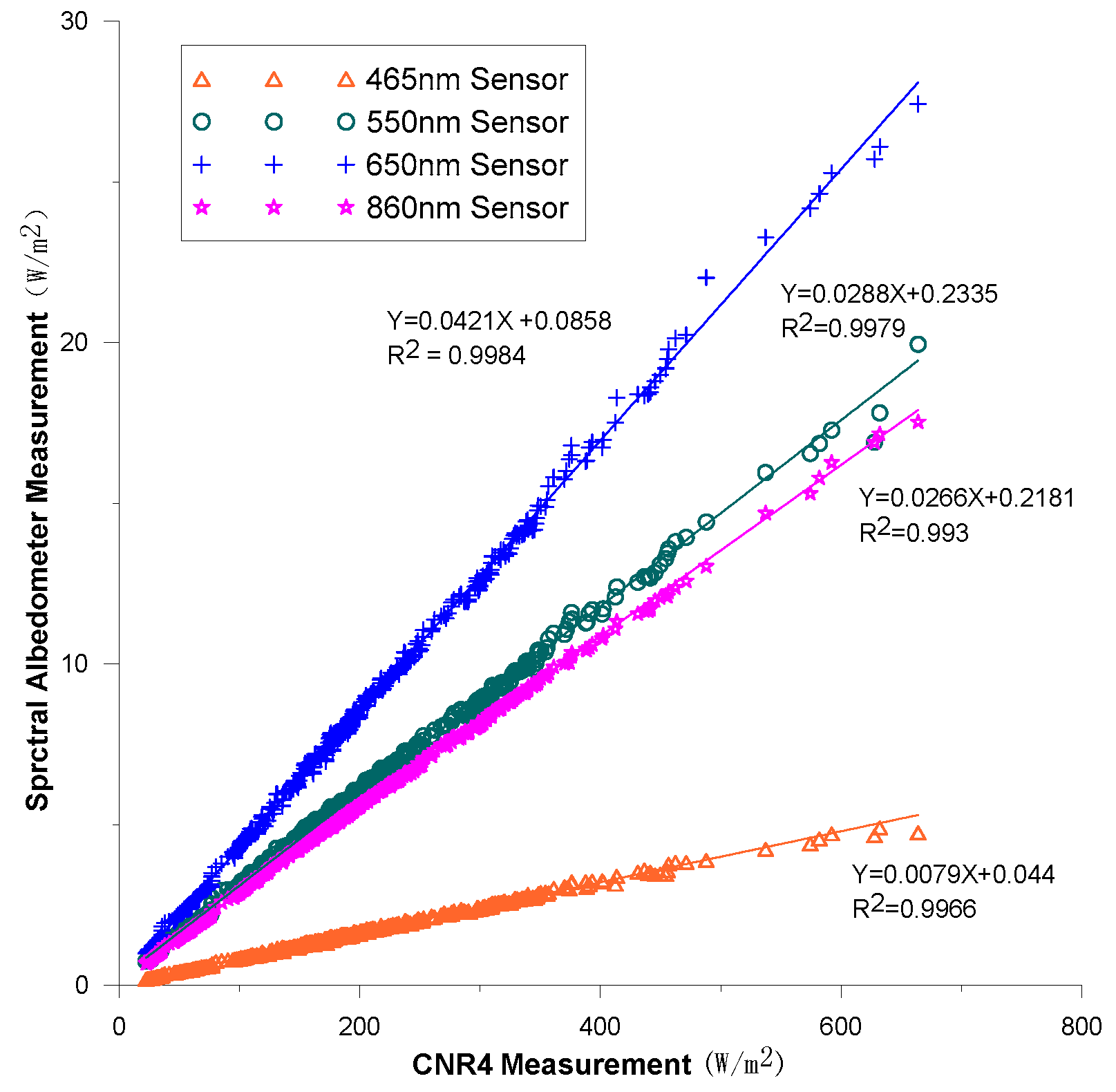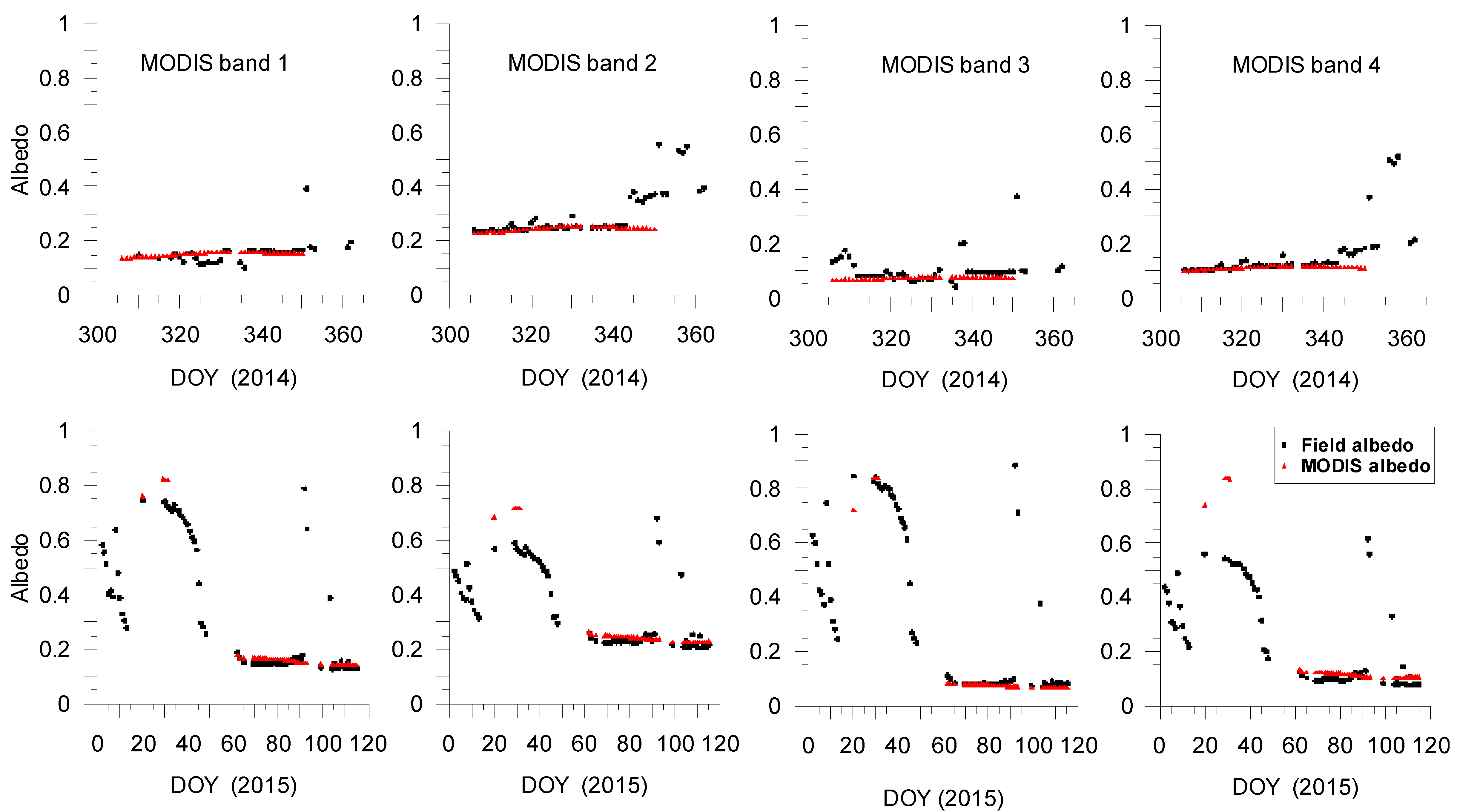Design of a Novel Spectral Albedometer for Validating the MODerate Resolution Imaging Spectroradiometer Spectral Albedo Product
Abstract
:1. Introduction
2. Spectral Albedometer Design
2.1. Theoretical Foundation
2.2. Spectral Albedometer Design
2.2.1. Dome and Cosine Corrector
2.2.2. Interference Filter
2.2.3. Silicon Photoelectric Detector
3. Results
3.1. Interference Filter Transmittance
3.2. Calibration
3.3. Comparison with Commercial Instrument
3.4. MODIS Spectral Albedo Product Validation
4. Discussion
4.1. Errors Induced by the Spectral Albedometer Design
4.2. Land Surface Homogeneity
4.3. Capability of Simultaneous Multi-Parameter Observation
5. Conclusions
- Strong linear response of the sensor: The sensor utilizes an interference filter equipped with sophisticated technology to gather incident radiation measurements over specific wavelength ranges. We used a highly sensitive photoelectric detector in our design which is simple and reliable, with a >99% linear response that fully satisfies the requirements for precise albedo detection, with an absolute accuracy of 0.02–0.05 [1].
- Flexibility in the sensor design: We ran a successful spectral albedo test using the MODIS band set as an example. Our design can be easily extended to other satellite sensors and other bands. A wide range of photodetectors can also be used for the direct measurement of broadband surface albedos with multi-band combinations.
- Applicability to multi-point observation layouts: Compared to other currently available radiometers, the materials necessary for our design are relatively inexpensive. To this effect, our sensor can realize multi-point layouts in a given heterogeneous area to resolve issues with single-point observations in representing remote sensing pixel values.
Acknowledgments
Author Contributions
Conflicts of Interest
References
- Dickinson, R.E. Land surface processes and climate surface albedos and energy-balance. Adv. Geophys. 1983, 25, 305–353. [Google Scholar]
- Wang, K.; Liang, S.; Schaaf, C.L.; Strahler, A.H. Evaluation of Moderate Resolution Imaging Spectroradiometer land surface visible and shortwave albedo products at FLUXNET sites. J. Geophys. Res. Atmos. 2010, 115. [Google Scholar] [CrossRef]
- Wang, Z.; Schaaf, C.B.; Strahler, A.H.; Chopping, M.J.; Román, M.O.; Shuai, Y.; Woodcock, C.E.; Hollinger, D.Y.; Fitzjarrald, D.R. Evaluation of MODIS albedo product (MCD43A) over grassland, agriculture and forest surface types during dormant and snow-covered periods. Remote Sens. Environ. 2014, 140, 60–77. [Google Scholar] [CrossRef]
- Wang, Z.; Zeng, X. Evaluation of snow albedo in land models for weather and climate studies. J. Appl. Meteorol. Climatol. 2010, 49, 363–380. [Google Scholar] [CrossRef]
- Lewis, P.; Disney, M.; Barnsley, M.; Muller, J.-P. Deriving albedo maps for HAPEX-Sahel from ASAS data using kernel-driven BRDF models. Hydrol. Earth Syst. Sci. Discuss. 1999, 3, 1–11. [Google Scholar] [CrossRef]
- Liang, S. Narrowband to broadband conversions of land surface albedo I: Algorithms. Remote Sens. Environ. 2000, 76, 213–238. [Google Scholar] [CrossRef]
- Schaaf, C.B.; Gao, F.; Strahler, A.H.; Lucht, W.; Li, X.; Tsang, T.; Strugnell, N.C.; Zhang, X.; Jin, Y.; Muller, J.-P.; et al. First operational BRDF, albedo nadir reflectance products from MODIS. Remote Sens. Environ. 2002, 83, 135–148. [Google Scholar] [CrossRef]
- Pinty, B.; Roveda, F.; Verstraete, M.M.; Gobron, N.; Govaerts, Y.; Martonchik, J.V.; Diner, D.J.; Kahn, R.A. Surface albedo retrieval from Meteosat: 1. Theory. J. Geophys. Res. Atmos. 2000, 105, 18099–18112. [Google Scholar] [CrossRef]
- Wang, D.; Liang, S.; He, T.; Yu, Y. Direct estimation of land surface albedo from VIIRS data: Algorithm improvement and preliminary validation. J. Geophys. Res. Atmos. 2013, 118, 577–586. [Google Scholar] [CrossRef]
- Wang, D.; Liang, S.; He, T.; Yu, Y.; Schaaf, C.; Wang, Z. Estimating daily mean land surface albedo from MODIS data. J. Geophys. Res. Atmos. 2015, 120, 4825–4841. [Google Scholar] [CrossRef]
- He, T.; Liang, S.; Wang, D. Direct Estimation of Land Surface Albedo From Simultaneous MISR Data. IEEE Trans. Geosci. Remote Sens. 2017, 55, 2605–2617. [Google Scholar] [CrossRef]
- Liang, S.; Fang, H.; Chen, M.; Shuey, C.J.; Walthall, C.; Daughtry, C.; Morisette, J.; Schaaf, C.; Strahler, A. Validating MODIS land surface reflectance and albedo products: Methods and preliminary results. Remote Sens. Environ. 2002, 83, 149–162. [Google Scholar] [CrossRef]
- Wang, K.; Liu, J.; Zhou, X.; Sparrow, M.; Ma, M.; Sun, Z.; Jiang, W. Validation of the MODIS global land surface albedo product using ground measurements in a semidesert region on the Tibetan Plateau. J. Geophys. Res. Atmos. 2004, 109. [Google Scholar] [CrossRef]
- Cescatti, A.; Marcolla, B.; Santhana Vannan, S.K.; Pan, J.Y.; Román, M.O.; Yang, X.; Ciais, P.; Cook, R.B.; Law, B.E.; Matteucci, G.; et al. Intercomparison of MODIS albedo retrievals and in situ measurements across the global FLUXNET network. Remote Sens. Environ. 2012, 121, 323–334. [Google Scholar] [CrossRef]
- Song, J.; Gao, W. An improved method to derive surface albedo from narrowband AVHRR satellite data: Narrowband to broadband conversion. J. Appl. Meteorol. 1999, 38, 239–249. [Google Scholar] [CrossRef]
- Valiente, J.; Nunez, M.; Lopez-Baeza, E.; Moreno, J. Narrow-band to broad-band conversion for meteosat-visiible channel and broad-band albedo using both AVHRR-1 and-2 channels. Remote Sens. 1995, 16, 1147–1166. [Google Scholar] [CrossRef]
- Lucht, W.; Hyman, A.H.; Strahler, A.H.; Barnsley, M.J.; Hobson, P.; Muller, J.-P. A comparison of satellite-derived spectral albedos to ground-based broadband albedo measurements modeled to satellite spatial scale for a semidesert landscape. Remote Sens. Environ. 2000, 74, 85–98. [Google Scholar] [CrossRef]
- Picard, G.; Libois, Q.; Arnaud, L.; Verin, G.; Dumont, M. Development and calibration of an automatic spectral albedometer to estimate near-surface snow SSA time series. Cryosphere 2016, 10, 1297–1316. [Google Scholar] [CrossRef] [Green Version]
- Cheng, J.; Liang, S. Estimating the broadband longwave emissivity of global bare soil from the MODIS shortwave albedo product. J. Geophys. Res. Atmos. 2014, 119, 614–634. [Google Scholar] [CrossRef]
- Wuttke, S.; Seckmeyer, G.; König-Langlo, G. Measurements of spectral snow albedo at Neumayer, Antarctica. Ann. Geophys. 2006, 24, 7–21. [Google Scholar] [CrossRef] [Green Version]
- Wright, P.; Bergin, M.; Dibb, J.; Lefer, B.; Domine, F.; Carman, T.; Carmagnola, C.; Dumont, M.; Courville, Z.; Schaaf, C.; et al. Comparing MODIS daily snow albedo to spectral albedo field measurements in Central Greenland. Remote Sens. Environ. 2014, 140, 118–129. [Google Scholar] [CrossRef]
- Grenfell, T.C.; Warren, S.G.; Mullen, P.C. Reflection of solar radiation by the Antarctic snow surface at ultraviolet, visible, and near-infrared wavelengths. J. Geophys. Res. Atmos. 1994, 99, 18669–18684. [Google Scholar] [CrossRef]
- Hudson, S.R.; Warren, S.G.; Brandt, R.E.; Grenfell, T.C.; Six, D. Spectral bidirectional reflectance of Antarctic snow: Measurements and parameterization. J. Geophys. Res. Atmos. 2006, 111. [Google Scholar] [CrossRef]
- Marks, A.; Fragiacomo, C.; Macarthur, A.; Zibordi, G.; Fox, N.; King, M.D. Characterisation of the HDRF (as a proxy for BRDF) of snow surfaces at Dome C, Antarctica, for the inter-calibration and inter-comparison of satellite optical data. Remote Sens. Environ. 2015, 158, 407–416. [Google Scholar] [CrossRef]
- Feister, U.; Grewe, R. Spectral albedo measurements in the UV and visible region over different types of surfaces. Photochem. Photobiol. 1995, 62, 736–744. [Google Scholar] [CrossRef]
- Angström, A. The albedo of various surfaces of ground. Geogr. Ann. 1925, 7, 323–342. [Google Scholar]
- King, D.L.; Myers, D.R. Silicon-photodiode pyranometers: Operational characteristics, historical experiences, and new calibration procedures. In Proceedings of the Conference Record of the Twenty Sixth IEEE Photovoltaic Specialists Conference—1997, Anaheim, CA, USA, 29 Septemebr–3 October 1997. [Google Scholar]
- Michalsky, J.; Harrison, L.; Berkheiser Iii, W. Cosine response characteristics of some radiometric and photometric sensors. Sol. Energy 1995, 54, 397–402. [Google Scholar] [CrossRef]
- Lowry, J.H.; Mendlowitz, J.S. Optical characteristics of Teflon AF fluoroplastic materials. Opt. Eng. 1992, 31, 1982–1985. [Google Scholar] [CrossRef]
- Martínez, M.A.; Andújar, J.M.; Enrique, J.M. A new and inexpensive pyranometer for the visible spectral range. Sensors 2009, 9, 4615–4634. [Google Scholar] [CrossRef] [PubMed]
- Apfel, J.H. Infra-Red Interference Filter. U.S. Patent 3,682,528 A, 8 August 1972. [Google Scholar]
- Yokota, S.; Sugiyama, M.; Kawagoe, N.; Miyaura, T. Spectral Sensor with Interference Filter. U.S. Patent 4,822,998A, 18 April 1989. [Google Scholar]
- Ndukwe, I. Measurement of solar energy radiation at Okigwe using silicon solar cell. Energy Convers. Manag. 2000, 41, 189–197. [Google Scholar] [CrossRef]
- Xu, Z.; Liu, S.; Li, X.; Shi, S.; Wang, J.; Zhu, Z.; Xu, T.; Wang, W.; Ma, M. Intercomparison of surface energy flux measurement systems used during the HiWATER-MUSOEXE. J. Geophys. Res. Atmos. 2013, 118. [Google Scholar] [CrossRef]
- Lucht, W.; Schaaf, C.B.; Strahler, A.H. An algorithm for the retrieval of albedo from space using semiempirical BRDF models. IEEE Trans. Geosci. Remote Sens. 2000, 38, 977–998. [Google Scholar] [CrossRef]
- Shuai, Y. Tracking Daily Land Surface Albedo and Reflectance Anisotropy with MODerate-Resolution Imaging Spectroradiometer (MODIS); Boston University: Boston, MA, USA, 2010; p. 118. [Google Scholar]
- Lewis, P.; Barnsley, M.J. Influence of the sky radiance distribution on various formulations of the Earth surface albedo. In Proceedings of the International Symposium on Physical Measurements & Signatures in Remote Sensing Isprs, Val d’Isere, France, 17–24 January 1994. [Google Scholar]
- Hubaks, P.; Platnik, S.; King, M.; Ridgway, B. MODIS Atmosphere L3 Gridded Product Algorithm Theoretical Basis Document (ATBD) & Users Guide; MODIS Algorithm Theoretical Basis Document No. ATBD-MOD-30. Available online: https://modis-atmos.gsfc.nasa.gov/_docs/L3_ATBD_C6_2015_05_06.pdf (accessed on 9 January 2018).
- Remer, L.A.; Tanre, D.; Kaufman, Y.J.; Levy, R.; Mattoo, S. Algorithm for Remote Sensing of Tropospheric Aerosol from MODIS: Collection 005. Natl. Aeronaut. Space Admin. Available online: https://pdfs.semanticscholar.org/566d/19c074f199963abba848ad53b77062d1333d.pdf (accessed on 9 January 2018).
- Calleja, J.F.; Recondo, C.; Peón, J.; Fernández, S.; De La Cruz, F.; González-Piqueras, J. A New Method for the Estimation of Broadband Apparent Albedo Using Hyperspectral Airborne Hemispherical Directional Reflectance Factor Values. Remote Sens. 2016, 8, 183. [Google Scholar] [CrossRef]
- Degenhardt, C.; Prescher, G.; Frach, T.; Thon, A.; De Gruyter, R.; Schmitz, A.; Ballizany, R. The digital silicon photomultiplier—A novel sensor for the detection of scintillation light. In Proceedings of the 2009 IEEE Nuclear Science Symposium Conference Record (NSS/MIC), Orlando, FL, USA, 24 October–1 November 2009. [Google Scholar]
- He, T.; Liang, S.; Wang, D.; Cao, Y.; Gao, F.; Yu, Y.; Feng, M. Evaluating land surface albedo estimation from Landsat MSS, TM, ETM+, and OLI data based on the unified direct estimation approach. Remote Sens. Environ. 2018, 204 (Suppl. C), 181–196. [Google Scholar] [CrossRef]
- Wang, Z.; Schaaf, C.B.; Chopping, M.J.; Strahler, A.H.; Wang, J.; Román, M.O.; Rocha, A.V.; Woodcock, C.E.; Shuai, Y. Evaluation of Moderate-resolution Imaging Spectroradiometer (MODIS) snow albedo product (MCD43A) over tundra. Remote Sens. Environ. 2012, 117, 264–280. [Google Scholar] [CrossRef]
- Burakowski, E.A.; Ollinger, S.V.; Lepine, L.; Schaaf, C.B.; Wang, Z.; Dibb, J.E.; Hollinger, D.Y.; Kim, J.; Erb, A.; Martin, M. Spatial scaling of reflectance and surface albedo over a mixed-use, temperate forest landscape during snow-covered periods. Remote Sens. Environ. 2015, 158, 465–477. [Google Scholar] [CrossRef]
- Proctor, D.; Trickett, E. An improved pyranometer. Sol. Energy 1982, 29, 189–194. [Google Scholar] [CrossRef]
- Beaubien, D.; Bisberg, A.; Beaubien, A. Investigations in pyranometer design. J. Atmos. Ocean. Technol. 1998, 15, 677–686. [Google Scholar] [CrossRef]











| Band 1 | Band 2 | Band 3 | Band 4 | |
|---|---|---|---|---|
| Central wavelength (nm) | 645 | 858.5 | 469 | 555 |
| Full width at half maximum (FWHM) (nm) | 50 | 35 | 20 | 20 |
| Band 1 | Band 2 | Band 3 | Band 4 | |
|---|---|---|---|---|
| Central wavelength (nm) | 645 | 858.5 | 469 | 555 |
| FWHM (nm) | 45 | 38 | 22 | 21 |
| RMSE | BIAS | |
|---|---|---|
| Band 1 | 0.019 | −0.0094 |
| band 2 | 0.0368 | 0.0065 |
| band 3 | 0.0317 | 0.0159 |
| band 4 | 0.0244 | −0.0001 |
© 2018 by the authors. Licensee MDPI, Basel, Switzerland. This article is an open access article distributed under the terms and conditions of the Creative Commons Attribution (CC BY) license (http://creativecommons.org/licenses/by/4.0/).
Share and Cite
Zhou, H.; Wang, J.; Liang, S. Design of a Novel Spectral Albedometer for Validating the MODerate Resolution Imaging Spectroradiometer Spectral Albedo Product. Remote Sens. 2018, 10, 101. https://doi.org/10.3390/rs10010101
Zhou H, Wang J, Liang S. Design of a Novel Spectral Albedometer for Validating the MODerate Resolution Imaging Spectroradiometer Spectral Albedo Product. Remote Sensing. 2018; 10(1):101. https://doi.org/10.3390/rs10010101
Chicago/Turabian StyleZhou, Hongmin, Jindi Wang, and Shunlin Liang. 2018. "Design of a Novel Spectral Albedometer for Validating the MODerate Resolution Imaging Spectroradiometer Spectral Albedo Product" Remote Sensing 10, no. 1: 101. https://doi.org/10.3390/rs10010101






